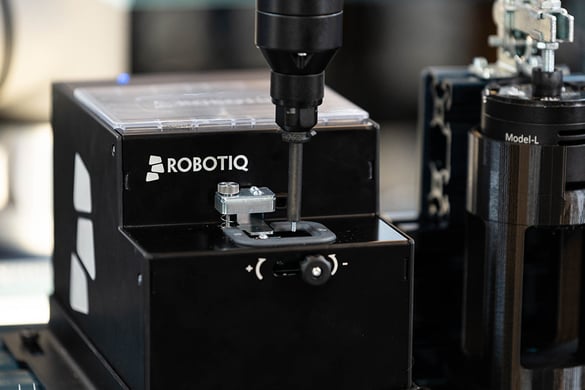How to Combine an Automatic Screwdriver With a Tool Changer

Posted on Apr 05, 2022 in Automation
5 min read time
Picture your product as it moves down the assembly line. As it comes into a new station, the operator grabs the electric screwdriver, picks up a screw, and fastens it. The next step needs a lower torque for a different type of screw, so your operator puts down the current screwdriver and reaches for another one. Although this all sounds simple for a human, fastening multiple types of screws within the same assembly is a complex automation project. But it doesn’t have to be if you use a tool changer.
What's a tool changer?
A tool changer lets the robot switch between different tools without any operator intervention. It usually has two parts: one that is fixed on the robot wrist, and another that is fixed on the tool itself. Both parts fit together to allow the robot to “pick up” the tool.
Depending on your application, it’s also possible to provide compressed air and power to your tool through the tool changer, which reduces the need for cable management. Unused tools are stored on a support called a magazine. See our blog post on the top robot tool changers for more ideas.
 Credit: TripleA robotics
Credit: TripleA robotics
Why would you want a tool changer for screwdriving?
In an ideal scenario, a product would only need one type of screw for all its parts. However, because of design constraints, you probably have screws with different drive sizes in your assembly and therefore require multiple screwdrivers to fasten them. So what are your automation options?
- Multiple robots that each have their own screwdriver
- Pro: Fast.
- Con: Expensive and complex, because you need to set up communication between the robots.
- One robot with multiple screwdrivers
- Pro: Less expensive than option one.
- Con: You can’t use that many different tools. Tool selection is limited by your payload, and complex to program (since you’re constantly switching the orientation of your tool center point).
- One robot with a bit changer
- Pro: Easy to program and flexible, so you can add as many screwdriving bits as you like.
- Con: Picking up and putting down a screwdriving bit increases cycle time.
- One robot with a tool changer
- Pro: Easy to program and flexible, so you can add as many tools as you like.
- Con: Picking up and putting down a tool increases cycle time.
Which applications are tool changers good for?
Tool changers are great for:
- Screwdriving applications with more than two types of screws.
- Applications that involve screwdriving and other types of tools like a gripper or glue gun.
- Applications where cycle time is not that important, since cycle time will be slower due to changing and activating tools.
How do tool changers affect cycle time?
Using a tool changer will take some precious cycle time. Here’s a breakdown of a tool-changing sequence:
- Tool change from empty to equipped.
- Power on + activation.
- Travel between the tool changer magazine and the part.
- Process.
- Travel between the part and the tool changer magazine.
- Tool change from equipped to empty.
However, it’s possible to save some cycle time using the following tricks.
1) Robot movement
Place the tool changer’s magazine as close as possible to your part so the robot doesn’t have to travel far to switch tools. Also, you should be using the "Blend with radius" option that can be found in the waypoint node (see UR eLearning for details).
2) Activate tools while moving
Don’t wait for the tool to activate before moving the robot. Use a thread to run the activation at the same time, and add some “Wait” nodes to make sure the tool is activated before being used in the process.
In the example below, a variable called gripperON indicates when to start the activation sequence.
|
Main program |
Parallel thread |
|
|
|
3) Measure how tool change affects cycle time
You can use the “Timer” node at different moments in your program to measure how long each step takes. This way, you can track your progress as you tweak your program and pinpoint which step needs more work.
Conclusion
Using a tool changer with multiple screwdrivers is the way to go when your robot needs to fasten multiple types of screws within the same assembly. It lets you tackle this complex process in a way that is accessible and flexible.

A good place to start your screw fastening automation project is to look at our screwdriving solution. This gives you an overview of a fully integrated solution that is easy to deploy to your assembly lines. It also includes our screwdriving fit tool where you can validate your own needs for your specific setup.
Ever thought of using a tool changer to make your screwdriving process more complete? Tell us in the comments below or join the discussion on LinkedIn, Twitter, Facebook, or the DoF professional robotics community.








Leave a comment